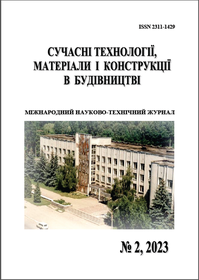НАПРЯМКИ ПОКРАЩЕННЯ ОСНОВНИХ ХАРАКТЕРИСТИК ТЕПЛОВИХ АКУМУЛЯТОРІВ ТА ТЕПЛОАКУМУЛЯЦІЙНИХ МАТЕРІАЛІВ
DOI:
https://doi.org/10.31649/2311-1429-2023-2-159-166Ключові слова:
енергозбереження; тепловий акумулятор (ТА); теплоакумулюючий матеріал (ТАМ); ємнісний акумулятор; фазовий перехід; альтернативні джерела енергії; теплоємність; зворотні хімічні реакції; ендотермічні та екзотермічні реакції.Анотація
Стаття присвячена дослідженню теплоакумулюючих технологій як основного заходу з енергозбереження. В роботі проведено патентний пошук та аналіз наукових праць, у яких висвітлено питання та викладений основний матеріал існуючих технологій акумулювання теплової енергії. Наведено класифікацію основних типів теплоакумуляторів (ТА) та теплоакумуляційних матеріалів (ТАМ). Теплоакумулятори класифіковані: за природою акумулювання; за рівнем робочих температур; за тривалістю періоду заряду-розряду. Проаналізовано відмінності та конструктивні особливості ТА, переваги і недоліки. Визначено основні теплоакумулюючі матеріали, які фактично використовуються або можуть використовуватись в подальшому. Описано теплофізичні властивості теплоакумулюючих матеріалів, так як: питома теплоємність, теплота плавлення, густина та щільність.
Визначено методику розрахунку об’єму ємнісного та фазоперехідного теплових акумуляторів за наступними вихідними даними: прийнятий тип теплоакумулюючого матеріалу, тип та теплові характеристики теплоносія, прийнятий перепад температури теплоакумулюючого матеріалу. Наведено приклади практичного використання ємнісних акумуляторів, зокрема бак-акумулятора в системі сонячного опалення, а також гравійного акумулятора у прибудинковій теплиці типу «сонячний вегетарій». Описано використання кристалогідратів та органічних легкоплавких сполук (жирні кислоти та парафіни) як фазоперехідних теплоакумуляційних матеріалів. Наведено характеристику термохімічних теплових акумуляторів, їх принцип дії, а також їх переваги над ємнісними та фазоперехідними акумулюючими установками. Описано реакції збагачення традиційного вуглецевого палива, а також наведено приклади реакцій, які можуть бути використані як теплоакумулюючі процеси. Визначено перспективи подальшого дослідження.
Посилання
Ratushnyak H.S., Dzhedzhula V.V., Anokhina K.V. Enerhozberihayuchi vidnovlyuvalʹni dzherela teplopostachannya [Tekst]: navchalʹnyy posibnyk. MON Ukrayiny, VNTU. Vinnytsya: VNTU, 2010. 170 s.
Vidnovlyuvani dzherela enerhiyi: monohrafiya / Barylo O. O., Kudrya S. O., Shynkarenko N. YA. [ta in.]; za red. S. Kudri. Kyyiv, Instytut vidnovlyuvanoyi enerhetyky NANU, 2020. 392 s. ISBN 978-966-999-077-8.
Kudrya S. O. Netradytsiyni ta vidnovlyuvani dzherela enerhiyi / Pidruchnyk: Kyyiv, NTUU «KPI», 2012. 492 s.
Ostapenko V.V., Ostapenko D.V., Luk'yanov O.V. Skhemy roboty akumulyatoriv teploty fazovoho perekhodu v systemakh teplopostachannya z kotlamy na orhanichnomu palyvi // Suchasne promyslove ta tsyvilʹne budivnytstvo. 2016. Tom 12, №2. S. 71-77.
Hrebenyuk O.M. Sposoby akumulyatsiyi enerhiyi netradytsiynykh dzherel // Hirnycha elektromekhanika ta avtomatyka. 2014. Vip. 93. S. 131-136. Rezhym dostupu: http://nbuv.gov.ua/UJRN/geta_2014_93_28.
Kozak KH.R., Zhelykh V.M. Otsinka ta analiz kharakterystyk teplovykh akumulyatoriv dlya povitryanykh heliosystem / Ventylyatsiya, osvitlennya ta teplohazopostachannya. Vip. 19, 2016. s. 65-70.
Thomas Bauer. Termalʹna enerhiya zberihannya materialiv i system / Th. Bauer, W. Steinmann, R. Tamme // Institute of Technical Thermodynamics. - Stuttgart. - 2012. - pp.131-177
Patent 21955 Ukrayina: MPK A01G 9/1. Teplytsya typu «Sonyachnyy vehetariy»/I. V. Kots, N. B. Ternovenko, O. P. Slipenʹka; zayavnyk ta vlasnyk patentu Vinnytsʹkyy natsionalʹnyy tekhnichnyy universytet. - № A200611434; zayavl. 30.10.2006; opubl. 10.04.2007, Byul. №4/2007.
Kots I. St, Hrytsun A. V., Bernik I. M., Yarmolyuk YU. M. Matematychne modelyuvannya teplomasoobminykh protsesiv teplytsi iz zastosuvannyam enerhozberihayuchykh tekhnolohiy // Zbirnyk naukovykh pratsʹ Vinnytsʹkoho natsionalʹnoho ahrarnoho universytetu. – 2001. – № 8. – S. 54-59.
Williams O. A comparison of reversible chemical reactions for solar thermochemical power generation / O. M. Williams // EDP Sciences. - Canberra. - 1980. - pp.453-461
Patent 6714 Ukrayina: MPK F24J2/14. Kombinovana systema sonyachnoho teplo- ta kholodopostachannya / I. O. Ponomarchuk. - № A20041109040; zayavl. 05.11.2004; opubl. 16.05.2005, Byul. №5, 2005 nar.
Teplovi akumulyatory enerhiyi. Metodychni vkazivky dlya studentiv spetsialʹnosti 133 «Haluzeve mashynobuduvannya» / Samoychuk K. O., Kovalʹov O. O. – Melitopolʹ: TDAU, 2018. – 20 s.
Henner Kerskes. Chemical energy storage using reversible solid/gas-reactions (CWS) - results of the search project / H. Kerskes, B. Mette, F. Bertsch, S. Asenbeck [etc] // Energy Procedia. - Stuttgart, 2012. - pp 294-304.
##submission.downloads##
-
PDF
Завантажень: 147
Опубліковано
Як цитувати
Номер
Розділ
Ліцензія

Ця робота ліцензується відповідно до Creative Commons Attribution 4.0 International License.


